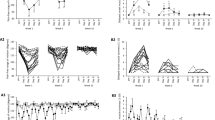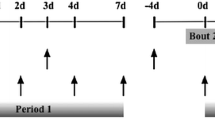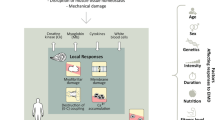Summary
Intensive training for and competition in endurance events like the marathon are accompanied by injury to fibres in the active skeletal muscles. Evidence for the injury comes from the increases in intramuscular enzymes and myoglobin found in the blood following the exercise, from the subjective sensation of soreness in the muscles in the post-exercise period, and from direct histological examination of samples of the damaged muscles. Histological studies demonstrate that some muscle fibres undergo degenerative changes following the exercise; the necrosis is accomplished by macrophages and other phagocytic cells that invade the injured cells and the adjacent interstitium. Following the degeneration the fibres appear to be regenerated so that there is not a net loss of fibres. Precisely what initiates the cellular damage is not known, but hypotheses suggested include, ‘metabolic overload’ and ‘mechanical strain’. Eccentric contractions are known to cause the greater amount of damage in muscles, which suggests that high local tensions in fibres may be more important than metabolic considerations in the aetiology of the injury. Training reduces the magnitude of the damage that occurs in response to a given exercise task, although competitors in endurance events may demonstrate chronic muscle injury because of increasing training intensities. Other than training, there is no compelling evidence that any drug treatment or preventative measures will lessen this form of injury.
Similar content being viewed by others
References
Abbott BC. Bigland B. Ritchie JM. The physiological cost of negative work. Journal of Physiology 117: 380–390. 1952
Abraham WM. Factors in delayed muscle soreness. Medicine and Science in Sports 9: 11–20. 1977
Allbrook D. Skeletal muscle regeneration. Muscle and Nerve 4: 234–245. 1981
Altland PD, Highman B. Effects of exercise on serum enzyme values and tissues of rats. American Journal of Physiology 201: 393–395, 1961
Apple FS, Rogers MA, Casal DC, Sherman WM, Ivy JL. Creatine kinase-MB isoenzyme adaptations in stressed human skeletal muscle of marathon runners. Journal of Applied Physiology 58: 149–153, 1985
Armstrong RB. Mechanisms of exercise-induced delayed onset muscular soreness: a brief review. Medicine and Science in Sports and Exercise 16: 529–538, 1984
Armstrong RB, Ogilvie RW, Schwane JA. Eccentric exercise-induced injury to rat skeletal muscle. Journal of Applied Physiology 54: 80–93, 1983
Asmussen E. Observations on experimental muscular soreness. Acta Rheumatica Scandinavica 2: 109–116, 1956
Bartsch RC, McConnell EE, Inus GD, Schmidt JM. A review of exertional rhabdomyolysis in wild and domestic animals and man. Veterinary Pathology 14: 314–324, 1977
Berg A, Haralambie G. Changes in serum creatine kinase and hexose phosphate isomerase activity with exercise duration. European Journal of Applied Physiology 39: 191–201, 1978
Bertorini T, Palmieri G, Bhattacharya S. Beneficial effects of dantrolene sodium in exercise-induced muscle pains: calcium mediated? Lancet 1: 616–617, 1982
Bigland BA, Lippold OCJ. The relation between force, velocity and integrated electrical activity in human muscles. Journal of Physiology 123: 214–224, 1954
Bigland-Ritchie B, Woods JJ. Integrated electromyogram and oxygen uptake during positive and negative work. Journal of Physiology (London) 260: 267–277, 1976
Bond-Peterson F, Knuttgen HG, Henriksson J. Muscle metabolism during exercise with concentric and eccentric contractions. Journal of Applied Physiology 33: 792–795, 1972
Bonner HW, Leslie SW, Combs AB, Tate CA. Effects of exercise training and exhaustion on 45Ca uptake by rat skeletal muscle mitochondria and sarcoplasmic reticulum. Research Communications in Chemical Pathology and Pharmacology 14: 767–770, 1976
Bowers WD, Hubbard RW, Smoake JA, Daum RC, Nilson E. Effects of exercise on the ultrastructure of skeletal muscle. American Journal of Physiology 227: 313–316, 1974
Brooke MH, Carroll JE, Davis JE, Hagberg JM. The prolonged exercise test. Neurology 29: 636–643, 1979
Busch WA, Stromer MH, Goll PE, Suzuki A. Ca2+-specific removal of Z lines from rabbit skeletal muscle. Journal of Cell Biology 52: 367–381, 1972
Carlson BM. The regeneration of skeletal muscle: a review. American Journal of Anatomy 137: 119–150, 1983
Carlson BM, Faulkner JA. The regeneration of skeletal muscle fibers following injury: a review. Medicine and Science in Sports and Exercise 15: 187–198, 1983
Cobb CR, deVries HA, Urban RT, Luekens CA, Bagg RH. Electrical activity in muscle pain. American Journal of Physical Medicine 54: 80–87, 1975
Cullen MJ, Appleyard ST, Bindoff L. Morphologic aspects of muscle breakdown and lysosomal activation. Annals of the New York Academy of Sciences 317: 440–464, 1979
Cullen MJ, Fulthorpe JJ. Phagocytosis of the A band following Z line and I band loss: its significance in skeletal muscle breakdown. Pathology 138: 129–143, 1982
Davies CTM, White MJ. Muscle weakness following eccentric work in man. Pflügers Archiv 392: 168–171, 1981
Dayton WR, Reville WJ, Goll DE, Stromer MH. A Ca2+-activated protease possibly involved in myofibrillar protein turnover: partial characterization of the purified enzyme. Biochemistry 15: 2159–2167, 1976
Demos MA, Gitin EL, Kagen LJ. Exercise myoglobinemia and acute exertional rhabdomyolysis. Archives of Internal Medicine 134: 669–673, 1974
deVries HA. Prevention of muscular distress after exercise. Research Quarterly 32: 177–185, 1960
deVries HA. Quantitative electromyographic investigation of the spasm theory of muscle pain. American Journal of Physical Medicine 45: 119–134, 1966
Dohm GL, Barakat H, Stephenson TP, Pennington SM, Tapscott EB. Changes in muscle mitochondrial lipid composition resulting from training and exhaustive exercise. Life Sciences 17: 1075–1080, 1975
Edington DW, Edgerton VR. The biology of physical activity, p. 282, Houghton-Mifflin Co., Boston, 1976
Fowler W, Gardner G, Kazerunin H, Lauvstad W. The effect of exercise on serum enzymes. Archives of Physical Medicine 49: 554–565, 1968
Friden J, Sjostrom M, Ekblom B. A morphological study of delayed muscle soreness. Experientia 37: 506–507, 1981
Friden J, Seger J, Sjostrom M, Ekblom B. Adaptive response in human skeletal muscle subjected to prolonged eccentric training. International Journal of Sports Medicine 4: 177–183, 1983a
Friden J, Sjostrom M, Ekblom B. Myofibrillar damage following intense eccentric exercise in man. International Journal of Sports Medicine 4: 170–176, 1983b
Geller SA. Extreme exertion rhabdomyolysis. Human Pathology 4: 241–250, 1973
Giddings CJ, Neaves WB, Gonyea WJ. Muscle fiber necrosis and regeneration induced by prolonged weight-lifting exercise in the cat. Anatomical Record 211: 133–141, 1985
Gollnick PD, King DW. Effect of exercise and training on mitochondria of rat skeletal muscle. American Journal of Physiology 216: 1502–1509, 1969
Greenberg J, Arneson L. Exertional rhabdomyolysis with myoglobinuria in a large group of military trainees. Neurology 17: 216–222, 1967
Hansen KN, Knudsen B, Brodthagen U, Jordal R, Paule PE. Muscle cell leakage due to long distance training. European Journal of Applied Physiology 48: 177–188, 1982
Hecht A, Schumann JH, Kunde D. Histologische und enzymhistochemische befunde am skelettmuskel der untrainierten ratte nach intensiver physischer belastung. Medizin und Sport (Berl) 15: 270–274, 1975
Highman B, Altland PD. Effects of exercise and training on serum enzyme and tissue changes in rats. American Journal of Physiology 205: 162–166, 1963
Hikida RS, Staron RS, Hagerman FC, Sherman WM, Costill DL. Muscle fiber necrosis associated with human marathon runners. Journal of Neurological Science 59: 185–203, 1983
Hough T. Ergographic studies in muscular soreness. American Journal of Physiology 7: 76–92, 1902
Howenstine JA. Exertion-induced myoglobinuria and hemoglobinuria. Journal of the American Medical Association 173: 493–499, 1960
Ishiura S, Sugita H, Nonaka I, Imakori K. Calcium-activated neutral protease: its localization in the myofibril, especially at the Z-band. Journal of Biochemistry 87: 343–346, 1980
Jones DA, Newham DJ. The effect of training on human muscle pain and damage. Journal of Physiology 365: 10P, 1985
Jones DA, Newham DJ, Round JM, Tolfree SEJ. Experimental human muscle damage: morphological changes in relation to other indices of damage. Journal of Physiology, in press, 1986
Karpati G, Carpenter S, Melmed C, Eisen AA. Experimental ischemic myopathy. Journal of Neurological Science 23: 129–161, 1974
Kasperek GJ, Snider RD. Increased protein degradation after eccentric exercise. European Journal of Applied Physiology 54: 30–34, 1985
Knochel JP. Rhabdomyolysis and myoglobinuria. Annual Review of Medicine 33: 435–443, 1982
Komi PV, Buskirk ER. Effect of eccentric and concentric muscle conditioning on tension and electrical activity of human muscle. Ergonomics 15: 417–434, 1972
Kuipers H, Drukker J, Frederik PM, Geurten P, Kranenburg Gv. Muscle degeneration after exercise in rats. International Journal of Sports Medicine 4: 45–51, 1983
Lindholm A, Johansson HE, Kjaersgaard P. Acute rhabdomyolysis (’tying-up’) in standardbred horses. Acta Veterinarica Scandinavica 15: 325–339, 1974
Makitie J, Teravainen H. Histochemical studies of striated muscle after temporary ischemia in the rat. Acta Neuropathologica 37: 101–109, 1977
Millar AP, Salmon J. Muscle tears. Australian Journal of Sports Medicine 2: 435–438, 1967
Newham DH, Mills KR, Quigley R, Edwards RHT. Muscle pain and tenderness after exercise. Australian Journal of Sports Medicine 14: 129–131, 1982
Newham DH, Jones DA, Edwards RHT. Large delayed plasma creatine kinase changes after stepping exercise. Muscle and Nerve 6: 380–385, 1983a
Newham DH, McPhail G, Mills KR, Edwards RHT. Ultrastructural changes after concentric and eccentric contractions of human muscle. Journal of Neurological Science 61: 109–122, 1983b
Newham DJ, Mills KR, Quigley BM, Edwards RHT. Pain and fatigue after concentric and eccentric muscle contractions. Clinical Science 64: 45–52, 1983c
Nimmo MA, Snow DH. Time course of ultrastructural changes in skeletal muscle after two types of exercise. Journal of Applied Physiology 52: 910–913, 1982
Oberc MA, Engel WK. Ultrastructural localization of calcium in normal and abnormal skeletal muscle. Laboratory Investigations 566-577, 1977
Oberholzer F, Claassen H, Moesch H, Howald H. Ultrastrukturelle, biochemische und energetische analyse liner extremen daverleistung (100 km-lauf). Schweizerische Zeitschrift fur Sportsmedizin 24: 71–98, 1976
Ogilvie RW, Hoppeler H, Armstrong RB. Decreased muscle function following eccentric exercise in the rat. Medicine and Science in Sports and Exercise 17: 195, 1985
Ryan AJ. Quadriceps strain, rupture and charlie horse. Medicine and Science in Sports 1: 106–111, 1969
Salminen A. Lysosomal changes in skeletal muscles during the repair of exercise injuries in muscle fibers. Acta Physiologica Scandinavica 124: 539, 1985
Salminen A, Vihko V. Susceptibility of mouse skeletal muscles to exercise injuries. Muscle and Nerve 6: 596–601, 1983
Salminen A, Hongisto K, Vihko V. Lysosomal changes related to exercise injuries and training-induced protection in mouse skeletal muscle. Acta Physiologica Scandinavica 120: 15–19, 1984
Salminen A, Vihko V. Autophagic response to strenuous exercise in mouse skeletal muscle fibers. Virchows Archiv 45: 97–106, 1984
Saltin B, Gollnick PD. Skeletal muscle adaptability: significance for metabolism and performance. Handbook of Physiology 10(19): 555–631, 1983
Schrier RW, Hano J, Keller HI, et al. Renal, metabolic and circulatory responses to heat and exercise. Annals of Internal Medicine 73: 213–223, 1970
Schumann HJ. Uberlastungsnekrosen der Skelettmuskulatur nach experimentellum laufzwany. Zentralblatt fur Allgemeine Pathologie und Pathologische Anatomie 116: 181–190, 1972
Schwane JA, Armstong RB. Effect of training on skeletal muscle injury from downhill running in rats. Journal of Applied Physiology 55: 969–975, 1983
Schwane JA, Watrous BG, Johnson SR, Armstrong RB. Is lactic acid related to delayed-onset muscle soreness? Physician and Sportsmedicine 11(3): 124–131, 1983
Shannon AD, Adams EP, Courtice FC. The lysosomal enzymes acid phosphatase and -glucuronidase in muscle following a period of ischaemia. Australian Journal of Experimental Biology and Medical Science 52: 157–171, 1974
Siegel AJ, Silverman LM, Holman BL. Elevated creatine kinase MB isoenzyme levels in marathon runners. Journal of the American Medical Association 246: 2049–2051, 1981
Stenger RJ, Spiro D, Scully RE, Shannon JM. Ultrastructural and physiologic alterations in ischemic skeletal muscle. American Journal of Pathology 40: 1–20, 1962
Tate CA, Bonner HW, Leslie SW. Calcium uptake in skeletal muscle mitochondria. II. The effects of long-term chronic and acute exercise. European Journal of Applied Physiology 39: 117–122, 1978
Tiidus PM, Ianuzzo CD. Effects of intensity and duration of muscular exercise on delayed soreness and serum enzyme activities. Medicine and Science in Sports and Exercise 15: 461–465, 1983
Travell J, Rinzler S, Herman M. Pain and disability of the shoulder and arm. Journal of the American Medical Association 120: 417–422, 1942
van Linge B. The response of muscle to strenuous exercise. Journal of Bone and Joint Surgery 44B: 711–721, 1962
Vertel RM, Knochel JP. Acute renal failure due to heat injury. American Journal of Medicine 43: 435–451, 1967
Vihko V, Rantamaki J, Salminen A. Exhaustive physical exercise and acid hydrolase activity in mouse skeletal muscle. Histochemistry 57: 237–249, 1978b
Vihko V, Salminen A, Rantamaki J. Acid hydrolase activity in red and white skeletal muscle of mice during a two-week period following exhausting exercise. Pflugers Archiv 378: 99–106, 1978b
Vihko V, Salminen A, Rantamaki J. Exhaustive exercise, endurance training, and acid hydrolase activity in skeletal muscle. Journal of Applied Physiology 47: 43–50, 1979
Walmsley B, Hodgson JA, Burke RE. Forces produced by medial gastrocnemius and soleus muscles during locomotion in freely moving cats. Journal of Neurophysiology 41: 1203–1216, 1978
Walton J. Diffuse exercise-induced muscle pain of undetermined cause relieved by verapamil. Lancet 1: 993, 1981
Wrogemann K, Pena SDJ. Mitochondrial calcium overload: a general mechanism for cell-necrosis in muscle diseases. Lancet 27: 672–673, 1976
Zammit VA, Newsholme EA. Effects of calcium ions and adenosine diphosphate on the activities of NAD+-linked isocitrate dehydrogenase from the radular muscles of the whelk and flight muscles of insects. Biochemical Journal 154: 677–687, 1976
Author information
Authors and Affiliations
Rights and permissions
About this article
Cite this article
Armstrong, R.B. Muscle Damage and Endurance Events. Sports Medicine 3, 370–381 (1986). https://doi.org/10.2165/00007256-198603050-00006
Published:
Issue Date:
DOI: https://doi.org/10.2165/00007256-198603050-00006




